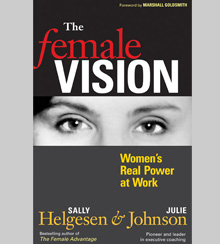Where Were the Women?
Harriet Rubin, author of The Princessa: Machiavelli for Women, introduces a passage on the urgent need for a more inclusive approach to leadership from The Female Vision: Women’s Real Power at Work, by Sally Helgesen and Julie Johnson.
In 1913, when Carl Jung was heir apparent to Sigmund Freud’s vast empire, he had a dream in which he saw rivers of blood spill over the world. Jung interpreted the dream as a sign that he was going crazy, that power and prestige had created a monster within him. He left London to start a small practice in an out-of-the-way Swiss clinic, working on ideas that would in the following decades coalesce into a new approach to healing. One year later, a crown prince was assassinated and the first world war began. The dream hadn’t meant that Jung was going crazy. The world was going crazy.
Jung asked himself, What is the crown prince that all Europeans need to kill? His answer: overreaching power. A story of greed, control, and ego was ending in a bloodbath that would reshape the princedoms of Europe.
Today, our trust in leaders is being undercut right and left. Bernard Madoff is no longer St. Bernard. “The smartest guys in the room” are unmasked as petty scoundrels. Auto executives travel in private jets to beg for billion dollar bailouts. Consequently, politicians elected by mandate suddenly can’t please anyone, and CEOs are deposed with increasing speed. These are signs that hero consciousness — society’s collective hero trip — needs to end.
That’s why we need to hear Sally Helgesen and Julie Johnson when they say that the world needs more women in leadership positions. Women care about connection more than dominance, about manifesting the new rather than preserving tradition. They are more familiar with contingency than control. As the coming decade unfolds, we may discover that, like Jung in the 20th century, Helgesen and Johnson have tapped into this century’s terrible teens. If so, their argument is even more compelling because it goes beyond gender equality to survival.
— Harriet Rubin
Excerpted from Chapter 3 of
The Female Vision: Women’s Real Power at Work
In part because of attrition and derailment and in part because of the persistence of the glass ceiling, women were underrepresented in senior positions in the companies implicated in the financial crisis — on Wall Street, but also in London, Sydney, Reykjavik, Dublin, Geneva, and Dubai. And women were almost entirely missing from the ranks of high-stakes dealmakers, merger-and-acquisition kings, buyout artists, and hedge fund entrepreneurs, whose access to capital had transformed the nature of finance in the decade before the meltdown.
Although women comprised the majority in many sectors of the workforce and had become proportionately better educated and more professionally skilled than men in many fields, they were not for the most part making the big financial decisions or placing the big bets. They were not pushing through the deals that changed how things were done. In the big leagues of finance, women still played mostly second string.
Of course, we will never know if having more women on boards or [in] positions of power could have averted or softened the crisis. But it’s clear in retrospect that an unbalanced leadership culture led some famed institutions over the cliff. Jacki Zehner, a former partner at Goldman Sachs, responded by funding a study with the National Council for Research on Women. The study finds that female hedge fund managers are less willing to assume a high degree of risk, less likely to take an attitude of “no guts, no glory.” As Zehner observes, “The companies [implicated in the crisis] needed more women leaders because they needed a more balanced decision-making model. Think what might have happened if Lehman Brothers had been Lehman Brothers and Sisters!”
The big problem was that the dominant culture — the culture in which Lehman Sisters were absent — offered women few opportunities to act upon what they noticed. But that didn’t stop women from noticing what was going on. They noticed that Vegas-style betting and a winner-take-all management style were hollowing out long-term value. They noticed that downsizing aimed at wowing the markets was often used to justify bloated pay-for-performance executive contracts. They noticed that corporate boards with 85 percent male leadership (the average) often did a remarkably poor job of reining in executives addicted to risk who rewarded themselves handsomely even when things were going wrong. They noticed that turbo-charged growth strategies and relentless acquisitions were often the result of numbers games that looked good on paper but did nothing to improve products, services, or customer satisfaction. And they noticed that their own progress seemed to have stalled while executives with dubious track records — some of whom had been leaving trails of wreckage behind them for decades — seemed to land on their feet.
Above all, women noticed that the quality of their own lives and the lives of those around them was deteriorating as organizations absorbed more risk and put more pressure on their people. It wasn’t just that people were working too hard and too long — although they often were. The larger problem lay with a system that had assumed a momentum of its own — a momentum that was out of sync with what most human beings require in order to live satisfying and harmonious lives.
Extreme demands were creating an extreme workplace, giving the most unbalanced and financially driven individuals an edge. These individuals in turn set the tone by hiring and promoting others who shared their values and their single-minded commitment to financial reward. Pay-for-performance contracts ratcheted up the intensity, with performance interpreted as the willingness to devote every waking hour to work. Talented people who valued balance, family life, or simply having sufficient time to make thoughtful decisions were seen as insufficiently tough or deemed to be underachievers. Not surprisingly, many women failed to thrive in this environment.
So…[questioning] whether more women in positions of power could have prevented the risky and grandiose wagers that led to disaster gets things precisely backward. Rather, the underrepresentation of women in senior positions was both a consequence and a symptom of a leadership culture that had grown increasingly unbalanced.
The inability of women to feel deeply engaged by this culture should have provided an early warning signal that trouble was brewing. But companies chose to view the retention of senior women as a women’s issue rather than a strategic or leadership concern. They compartmentalized the problem and so failed to see the link between talented women dropping by the wayside and a business culture focused on short-term and at times dubiously defined “results” to the exclusion of everything else. Both the goals and the methods of this culture were unsustainable. Companies were burning through profits as they burned through people.
— Sally Helgesen and Julie Johnson
Copyright (c) 2010 by Sally Helgesen and Julie Johnson. Reprinted with permission of Berrett-Koehler Publishers Inc.





